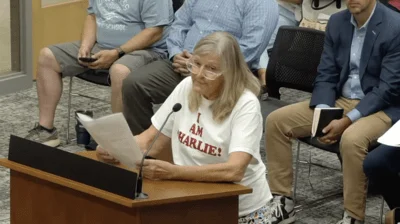City of Wheaton City Council Met April 12.
Here is the minutes provided by the council:
1. Call to Order
The Wheaton City Council Planning Session was called to order at 7:00 p.m. by Mayor Suess. The following were:
Physically Present:
Councilman Barbier
Councilwoman Bray-Parker
Councilwoman Fitch
Councilwoman Robbins
Councilman Rutledge
Mayor Suess
Councilman Zaruba
City Staff Physically Present: Michael Dzugan, City Manager
John Duguay, Assistant City Manager
Russell Peacock, Development Engineer
Joseph Tebrugge, Director of Engineering
Jim Kozik, Director of Planning & Economic Development
Susan Bishel, Public Information Officer
Daniel Peck, Public Relations Coordinator
2. Approval of March 22, 2021 Minutes
The Council approved the March 22, 2021 City Council Planning Session minutes.
3. Public Comment
There were no public comments.
4. Adding Parking Inventory Downtown
City Manager Dzugan provided a background of the City’s efforts to develop a strategy for adding parking inventory for the downtown area through the utilization of a parking deck. He stated that although the staff’s comprehensive analysis of parking has been interrupted by the Covid-19 pandemic, staff is aware of the existing parking inventory and anticipates an increase in the current utilization. He stated that staff expects more parking will be needed for visitors and employees of the downtown area as a result of the success of the streetscape development along with private and public investment.
City Manager Dzugan stated that staff had identified the north surface parking lot of City Hall as a viable option for the placement of a parking structure based on numerous characteristics. He stated that the City had its consultant, Walker Consultants, provide a preliminary analysis of a parking structure at this location. He stated that Walker Consultant provided three conceptual options with similar characteristics that include a four-story structure that is approximately 108,570 square feet with 330 total parking spaces and an estimated cost of approximately $10 million.
City Manager Dzugan stated that staff is seeking Council direction on continuing to explore a parking garage as realistic option for increasing parking inventory within the downtown area and identifying the triggers that would initiate further action.
City Manager Dzugan introduced Brad Navarro of Walker Consultants to review preliminary conceptual layouts of a parking structure on the north surface parking lot of City Hall.
Mr. Navarro presented the parameters that were considered for the parking structure study that included the potential users of the parking facility, the utilized property at City Hall, site compatibility, project proximity to Memorial Park, and the understanding that the parking facility would not be a mixed-use structure.
Mr. Navarro presented the goals that were considered for the parking structure study that included developing a “Shared Parking Concept” that would facilitate users in the daytime and nighttime, using the space efficiently, developing the project economically, creating sensible access to the site and structure, meeting zoning provisions, and analyzing levels of service for the overall structure.
Mr. Navarro presented drawings of three concepts and reviewed the proposed parking structure’s site plans, isometrics, traffic patterns, and massing models.
In response to questions from Council, Director Kozik stated that the height of the parking structure is controlled by the City’s zoning ordinances, which allow for up to a 50-foot structure.
In response to questions from Council, Mr. Navarro stated that the cost of adding an additional below-level parking platform would cost a 50% premium.
Assistant City Manager Duguay stated that there are approximately 10-12 City owned vehicles that would need to utilize the parking structure overnight. City Manager Dzugan stated that the City’s parking lot is open during the evening for public parking.
In response to questions from Council, City Manager Dzugan stated that the employees being discussed include both City employees and downtown employees. Director Kozik stated that there are policies in place to help find parking for downtown employees and reserve premium spaces for customers, but it is challenging to get downtown employees to not park in areas provided for customers.
In response to questions from Council, City Manager Dzugan stated that the Wheaton Place parking garage is a four-story structure that is approximately 152,000 square feet with 376 total parking spaces; and the Willow Avenue parking garage is a four-story structure that is approximately 148,000 square feet with 374 total parking spaces.
In response to questions from Council, Mr. Navarro stated that if the structure were built in the proposed area, the water detention area on the west end of the current parking lot would be addressed by incorporating storm traps to ease detention.
In response to questions from Council, Mr. Navarro stated that adding an additional level below ground could create approximately 90 parking stalls.
The Council requested City staff continue investigating a strategy for adding additional parking inventory for the downtown through the utilization of a parking deck. Council members expressed the desire for City staff to acquire parking and traffic data this summer, especially once more events begin to return to the downtown.
5. Sanitary Sewer Informational Review
City Manager Dzugan stated that staff was in the process of developing action plans for the 2020-2025 Strategic Plan, which includes a strategic goal of improving programs to reduce sanitary backups and overflows. The goal contains two initiatives that include identifying best practices to address overflows and create programs that provide relief for property owners experiencing basement backups.
City Manager Dzugan stated that the City’s Development Engineer Russell Peacock would be providing an overview of sanitary backups and overflows and presenting proposed revisions to the current programs to address both issues.
Development Engineer Peacock provided a background of the City’s sanitary system, stating that wastewater is transported from buildings into the sanitary sewer system through privately owned service laterals that are discharged into treatment plants. The majority of Wheaton is served by the Wheaton Sanitary District’s treatment plant, and some parts are served by DuPage County facilities.
Development Engineer Peacock stated that the main cause of sanitary sewer backups and overflows in Wheaton is groundwater and stormwater entering through defects, which overwhelm the sanitary sewer system during rain events creating inflow and infiltration (I&I). Public sector sources of I&I include defects in manholes, pipes, and storm sewer cross connections; and private sector sources of I&I include defects in service laterals and illicit connections such as sump pumps, downspouts, and foundation drains. He stated that the City averages 30 overflows per year and approximately 90% of the overflows are due to I&I.
In response to questions from Council, Development Engineer Peacock stated that the City cannot use the additional flow capacity of the Wheaton Sanitary District’s Southside Interceptor due to the deterioration of Basins 4 and 5. He stated that the basins are taking up the additional volume that was originally available when the Southside Interceptor was initially installed.
Development Engineer Peacock provided an overview of basement backups. He stated that the City’s Residential Sewer Backup Program currently reimburses residents 50% of the installation cost of an overhead sewer at a maximum amount of $3,000. He stated that on average the program is only used by 6 residents per year. He stated that staff estimates that there are approximately 800 backups City-wide varying in severity for a 10-year storm event.
Development Engineer Peacock stated that staff is proposing revisions to the City’s Residential Sewer Backup Program that include a reimbursement for residents of 75% of the installation cost of an overhead sewer at a maximum amount of $6,000. He stated that this would increase the annual budget from $30,000 to $100,000.
Development Engineer Peacock provided an overview of overflows. He stated that privately owned service laterals account for more than 50% of linear feet of the City’s total sanitary sewer system. Service laterals installed before 1980 are typically vitrified clay pipe, which are not in compliance with City Code and are more prone to leaking at the pipe joints.
Development Engineer Peacock stated that the City has less than 20 service lateral replacements per year, and averages approximately 80 sanitary sewer repair permits per year. He stated that the City’s Sanitary Sewer Service Line Reimbursement Program currently reimburses residents 50% of the cost of for service lateral repairs in the right-of-way at a maximum amount of $2,000. He stated there are approximately 5 residents per year who utilize the program. He stated that an issue with the current program is residents typically only repair a small length of the lateral service line pipe due to the higher costs of a complete service lateral replacement.
Development Engineer Peacock stated that staff is proposing revisions to the City’s Sanitary Sewer Service Line Reimbursement Program that include only reimbursing residents for the complete replacement or rehabilitation of their service lateral line from the building drain to the City sewer main; limiting the annual maximum participation in the program to 50 participants; maintaining reimbursement for residents at 50% of the cost of the project at a maximum amount of $5,000; and allowing backyard sewers to participate in the program. He stated that this would increase the annual budget from $20,000 to $250,000. Development Engineer Peacock stated Public Works will still be responsible for restorations to the right-of way, including the street patch.
Development Engineer Peacock stated that a challenge of the revised program will be that service lateral replacements will uncover originally installed foundation drains or sump pumps that are directly connected to the sanitary system, which will need to be removed, resulting in potential expensive remediation projects.
Development Engineer Peacock provided an overview of the current Capital Improvement Projects that relate to addressing the reduction of sanitary backups and overflows. These include the replacement of failing liners on Wesley Street and in phases of the Downtown Streetscape Project; the Basin 3 and 4 discharge replacement project; and the Basin 4 sewer lateral rehabilitation.
In response to questions from Council, Development Engineer Peacock stated that the Basin 3 and 4 discharge Capital Improvement Project will involve the replacement of sewer mains upstream of the Southside Interceptor to attain an adequate slope, which would eliminate the need for annual maintenance on those pipes and increase overall flow. He stated that design of the project is beginning this year and will be an approximate two-year design process.
In response to questions from Council, Development Engineer Peacock stated that the Wheaton Sanitary District Northside Interceptor project will begin construction this year.
City Manager Dzugan recommended that the Council prioritize revising the City’s Residential Sewer Backup Program to address the goal of reducing sanitary sewer back-ups and overflows. He stated that by increasing funding to the Residential Sewer Backup Program, the City may provide more incentive for residents to participate in the program.
In response to questions from Council, City Manager Dzugan stated that the City has an ordinance in place that requires residents to replace their entire service line if it is leaking.
In response to questions from Council, Development Engineer Peacock stated that lining service laterals, was completed in Pilot 1, is not a sustainable solution. He stated that overhead sewer installations could be more expensive if residents have a finished basement or service needs to be provided outside the residence.
In response to questions from Council, Development Engineer Peacock stated that the City inspects sewer mains and service lines when doing and underground or reconstruction work.
The Council requested City staff further investigate the incentives to increase the utilization of the programs.
6. City Council/City Staff Comments
Councilwoman Bray-Parker stated that the Recycling Extravaganza was a huge success and thanked City staff and volunteers for their service. She also wished a happy Ramadan to celebrating Wheaton residents.
Mayor Suess and Councilwoman Fitch echoed the success of the Recycling Extravaganza and suggested having additional events throughout the year.
Mayor Suess congratulated Councilman Barbier and Councilwoman Robbins on their re-election to the City Council, and welcomed Scott Weller and Scott Brown to the City Council. He stated he is looking forward to working with everyone.
7. Adjournment
The meeting was adjourned at 8:58 p.m.
https://www.wheaton.il.us/AgendaCenter/ViewFile/Minutes/_04122021-1623






 Alerts Sign-up
Alerts Sign-up